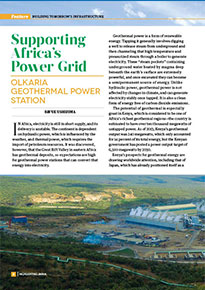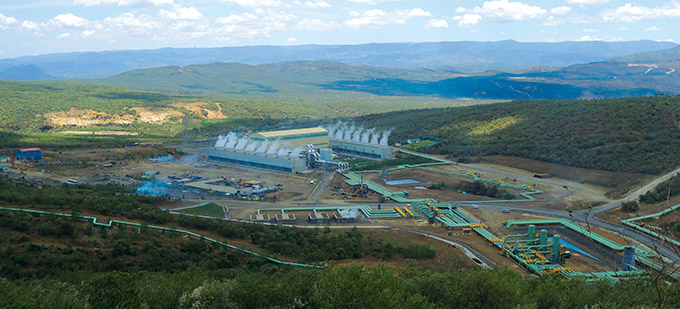Home > Highlighting JAPAN >Highlighting Japan December 2014>Building Tomorrow's Infrastructure
Highlighting JAPAN

Building Tomorrow's Infrastructure
Supporting Africa’s Power Grid
Olkaria Geothermal Power Station

In Africa, electricity is still in short supply, and its delivery is unstable. The continent is dependent on hydraulic power, which is influenced by the weather, and thermal power, which requires the import of petroleum resources. It was discovered, however, that the Great Rift Valley in eastern Africa has geothermal deposits, so expectations are high for geothermal power stations that can convert that energy into electricity.
Geothermal power is a form of renewable energy. Tapping it generally involves digging a well to release steam from underground and then channeling that high temperature and pressurized steam through a boiler to generate electricity. These “steam pockets” containing underground water heated by magma deep beneath the earth’s surface are extremely powerful, and once excavated they can become a semipermanent source of energy. Unlike hydraulic power, geothermal power is not affected by changes in climate, and can generate electricity stably once tapped. It is also a clean form of energy free of carbon dioxide emissions.
The potential of geothermal is especially great in Kenya, which is considered to be one of Africa’s richest geothermal regions—the country is estimated to have over ten thousand megawatts of untapped power. As of 2013, Kenya’s geothermal output was 240 megawatts, which only accounted for 14 percent of its total energy, but the Kenyan government has posted a power output target of 6,500 megawatts by 2030.
Kenya’s prospects for geothermal energy are drawing worldwide attention, including that of Japan, which has already positioned itself as a global leader in the area of geothermal research and development. Situated in the Pacific Ocean in what is known as the Ring of Fire, Japan is also a geothermally active country and has been investigating and investing in geothermal energy since 1919. In fact, Japan has the top share of boilers and plants in the world, and its experience and technology in the area of geothermal power plants is considered top class.
Since 2010, the Japan International Cooperation Agency (JICA) has been at the center of efforts to support Kenya’s construction of geothermal plants, offering technical cooperation and international yen loan projects from the initial survey stage on through to plant construction. Japan has also actively supported Kenya on the talent front, sending over thirty-five engineers from geothermal groups to the country. In turn, Kenya has sent over seventy trainees to Japan. After these plants are set up, Japan will shift its support in stages to help build facilities for distributing the power supply and enable private enterprise to enter the sector.
One area where a large-scale geothermal facility is taking form is Olkaria, which is seventy-five kilometers northwest of Kenya’s capital, Nairobi. Located within and around Hell’s Gate National Park, this verdant zone is ideal for geothermal power generation. Five geothermal power stations are being planned, and the plant JICA has been involved in building will alone be responsible for generating 210 megawatts of energy—the same amount all of Kenya’s current geothermal energy facilities are contributing.
Shin Maruo of JICA’s Africa Department says that as demand for energy in Kenya stabilizes, the area will become more attractive to Japanese firms. “Kenya is comparatively close to Japan and has a large international port, so some Japanese companies are looking to it as a new manufacturing base,” he notes. “Another appeal is its population size: the region, counting neighboring countries, has about 150 million people. However, factories cannot run without a stable power supply, so there is major interest in where these power plants will be situated.”
These geothermal power generation projects will not only be a powerful boost for Kenya’s economy, they will also create a foothold for the export of Japanese infrastructure as well as businesses moving into Africa. In addition, they will provide Japan a chance to show the world its strengths in the renewable energy realm, making them of major importance for the next generation.
© 2009 Cabinet Office, Government of Japan






